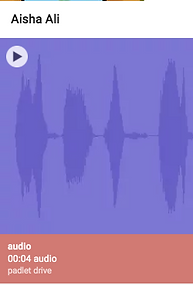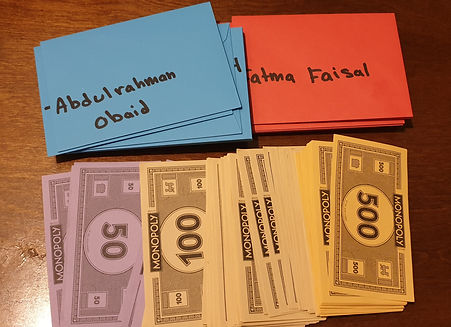Reflection on Practice
Page overview:
The following page is a display of my personal teaching strengths and weaknesses and ways in which I reflected on my work to implement the appropriate improvements.
Definition
Reflecting on practices involves the analysis of students' learning, a teacher's professional development, and using approaches that have been proven effective by research, all with the purpose of enhancing students' learning at the core (Nessipbayeva, 2012).
Levels of Reflection
Ward and McCotter set out four levels of reflection, consisting of lower and higher levels that depict the depth of reflections and actions taken to reflect on teaching practices. The levels are: Routine, Technical, Dialogic, and Transformative (Ward & McCotter, 2004).
Self-reflections
Year 2 Self-reflection

Description
Level of Reflection: Routine
When I was in my second year of the Education program, my self-reflections after each lesson were quite broad. They did not propose specific or useful recommendations on how I can improve my strategies in the future. They are considered within the routine level because they lacked curiosity and attention to complex underlying reasons of the issues.
Current Self-reflection
Area for Development
Improvement


Description
Description
In one of the lessons, I found that I had hurriedly explained the activities to students and so students were confused as to what they need to do.
During the following lesson, I created samples for each activity and showed students how their work should like. In addition, I explained each aspect clearly and received questions from students to clarify certain points.
Evidence

High Ability
Middle Ability
Low Ability
Reflection
Level of Reflection: Technical
Mentoring School Teacher (MST)
Reflective practices must lead to newfound conclusions that contribute to students' learning. In this level of reflection, concerns are reviewed and solutions are found to specific problems. In my view, it is important to self-reflect and monitor ones own performance in order to find solutions to problems.
Mentor Feedback

Description
My MST believed that I need to plan well for each section of the lesson so that students are not rushed due to lack of time.
Description
After I adjusted my strategies, my mentor commended my lesson sequencing skills and how each task was timed well. I was able to succeed in this by noting down the time in which each activity should be completed in, and timing myself to ensure I move on in time.



Description
The above activity samples showcase my attempt to provide students with samples that show them what their product should be like. I believe that using these examples gave students a better idea of what they should do.
Mentoring College Teacher (MCT)


Description
Description
My MCT pointed out that I should use more informative assessment techniques that allow me to collect meaningful data about students' learning.
After receiving the advice, I began searching for ways in which I can monitor learners and inform instruction using assessment data. Therefore, I implemented strategies such as giving and grading homework, using checklists and learning platforms that allow me to monitor students' work like Nearpod.
Seeking Feedback
Reflection
Level of Reflection: Dialogic
By seeking feedback and implementing recommendations, I am reflecting in the dialogic level as I continue to discuss my own teaching techniques with others and consider their views on how I can improve. It also includes the process of inquiry as I consistently ask questions and work on applying new pedagogical techniques. I believe that involving others in the process of reflection can be very beneficial, especially because they can give us new perspectives to look at.
Description
For my Professional Development Plan (PDP), I had three goals that I wanted to accomplish, which are to plan for challenging activities for the low achievers, reduce my teacher talking time, and improve my reflective writing. In order to find out if I had made progress toward these goals, I asked my MST to fill out some evaluations.
Click to find an outline of my goals:
Reflection
Reflections must incorporate dialogue, discussions with others, and taking in various perspectives (Ward & McCotter, 2004). Thus, when I made time to seek feedback from others, it benefited me and my reflective abilities. One of my PDP goals is to improve my written reflection and I believe this attitude helped me improve my writing.
Link to goal:
Level of Reflection: Dialogic
Action Plan

Mentoring School Teacher (MST)
Description
Overall, my MST believes I need to challenge high achievers more and plan for complex tasks that they can engage in.
Effective Behavior Management Strategies


Rationale
According to Smardon & Charteris (2010), "Listening means allowing what the other says to break through one's own preconceptions and prejudgments" (p.2). Moreover, a teacher's knowledge relates to experiences in teaching including trial and error. These experiences are further developed when expressed verbally and shared with others, leading to the enhancement of teaching skills (Postholm, 2019). As a novice teacher, it is important to consider other people's views and use their feedback to improve my teaching strategies.
Description
Description
In the past, I used to utilize the traffic lights technique, in which students with good behavior are in the green circle, a warning puts them in the yellow circle, and the red indicates they must be punished. However, I found that the students who I was targeting with this strategy tend to misbehave more when their names are moved.
After implementing a reward system technique, I noticed that learners who previously misbehaved, began to act more cautiously as they wanted to receive a reward.
Rationale
A study by Madsen, Becker and Thomas (1968) showed that commanding students to stop unwanted behavior tends to increase that behavior. It is implied that placing less emphasis on bad behavior, while praising good behavior could bring more positive results (n.p.). Therefore, I believe creating an encouraging atmosphere works best.
My philosophy regarding teaching talks about the importance of planning, because doing research leads to the understanding of current effective strategies proven by research.


